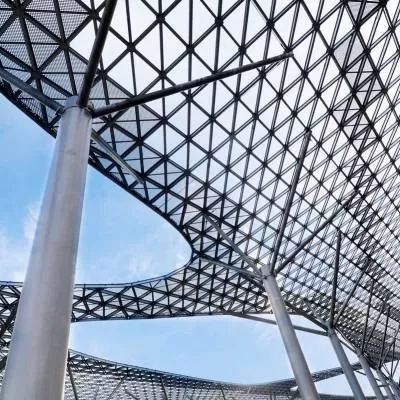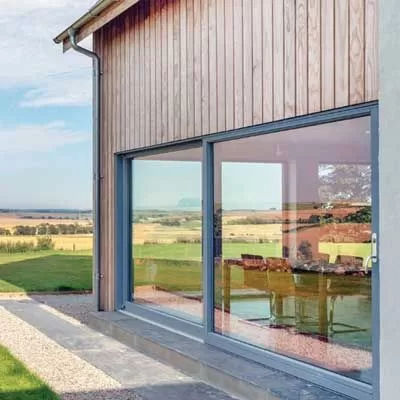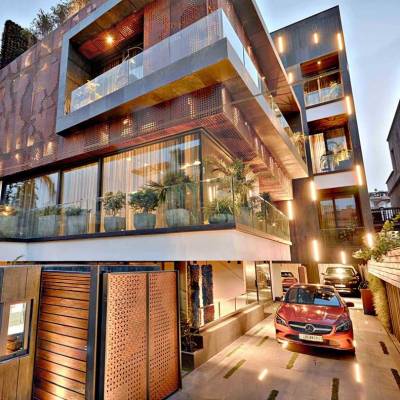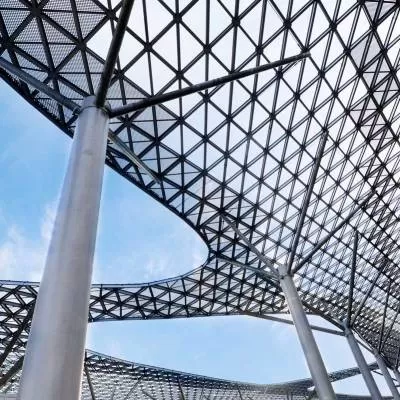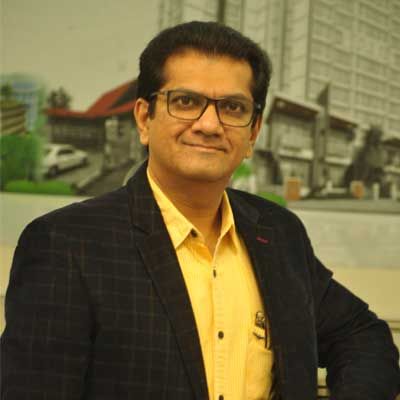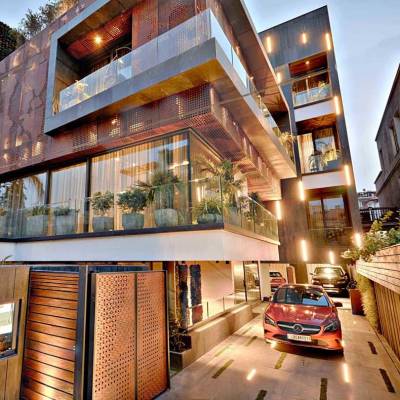- Home
- Real Estate
- Seamless Cover

Seamless Cover
The size of the total Indian roofing market is over 1 billion sq m, with a continuous evolution in the market for cladding.
Manish Garg, President and CEO-Steel Building Business, Everest Industries, divides the roofing market into three parts: 'Rural retail (led by the use of cement sheets); industrial or infrastructure; and urban retail.'Cement sheets maintain their virtual market share of over 75 per cent in rural retail; in industrial, it is mainly metal sheets. The roofing and cladding industry has seen a perception shift. Gautam Suri, Founder Director & CTO, Interarch Building Products, says, 'The steel roofing industry has registered good growth over the past few years, with an approximate market size of 1.2 million tonne.'
The market for cladding has come a long way. 'The total size of the Indian façade market is estimated at over 80 million sq m per annum,'says Dr Prashanth Reddy, Managing Director, FunderMax India. 'Glass takes a majority share, followed by stone, aluminium composite panels, and about 5 per cent by new-generation materials like HPL, fibre cement boards and natural woods like IPE.'The industry is catching up quickly with international trends in building envelope design and the use of materials like ceramic tiles and metal panels.
Trending features
Nowadays, roofs are customised to a greater extent; design alterations are made depending on the building type, size and requirement. Suri says, 'We are seeing roofing trends - green and eco-friendly materials, energy-efficient roofing, and lighter colour roofs -offering a variety of benefits.'
Metal roofs are trending across applications such as commercial, industrial and exhibition centres. 'These roofs come with GI or aluminium-zinc (Al-Zn) coating and are durable,'explains Garg. 'Aluminium colour-coated roofs are also catching up fast owing to their corrosion-resistant properties. Various shingles and tile profiles are being used in malls, villas and cottage projects.'
Different types of roof systems are used globally, such as thermoplastic polyolefin (TPOs), built-up roof systems, torch-applied roof systems, etc. Tremco has been involved in various types of roofing systems too. Chuck Houk, President, Tremco Incorporated, says, 'Internationally, we promote the liquid-applied roof system because it is monolithic, has a polyurethane membrane coat, and there are no seams. It can also be applied over existing roof systems to extend life.'
Indian customers are price-sensitive, and cladding is still considered more from an aesthetic point of view than functional performance. 'Of late, this has changed though and there is increasing awareness about the importance of durable, sustainable and easy-to-maintain cladding products,'says Dr Reddy. With the energy crisis and a focus on sustainable building, the demand for energy-efficient products is increasing. FunderMax offers exterior applications like Max Exterior F Quality, Lap Siding, perforated panels and different surfaces like glossy, matte, textures, individual and customised digital prints, etc. Dr Reddy observes, 'Although the market preference is tilted towards wooden grains, we see our white decor doing well in the corporate and builders' segment, and a lot of stone decor catching interest to replace most of natural stone owing to its weight and porosity issues.'For interior applications in India, Fundermax currently offers Max Resistance2 - highly chemical-resistant HPL panels for laboratory tabletops.
Metal is in
Metal sheets are light yet strong; cost less over the service life of the roof; and accommodate green technologies such as solar harvesting panels or water harvesting systems. 'So, it is a value for investment,'says Jawahar Lal Das, COO, Safintra Roofing India. 'Insulated metal roofing and cladding is more thermally-efficient than conventional roof tiles. It can last up to 10-20 years and outlasts other roofing products in severe weather conditions. Also, being lightweight, it reduces structural load, is beneficial in seismic areas and retrofitting projects. With its fire-resistance properties, it reflects heat effectively and can be recycled without losing any valuable properties.'Moreover, it offers extensive design flexibility and makes installation and construction easy.
Safintra has introduced its standing seam product SAFZIP 400 and clip lock product SAFLOK 700 as sustainable roofing solutions. It also has a mobile roofing solution for both systems, helpful at large installations if the sheets are long and cannot be transported on the road.
Coating is an essential element in steel roofs. Das says that it is durable and provides material warranties of 10-15 years for AZ 150/200. Zinc coating will double the service life of steel, but Al-Zn coating gives 4x longer life than zinc-coated steel, considering the same coating thickness. Also, Al-Zn coated steel retains its reflectivity for longer than galvanised coating, creating a cooler roof.
Advancements in cladding
Technological innovations have given rise to more robust, energy-efficient, innovative and adaptable façade systems such as back-ventilated, double-skin, louvers and energy-efficient façade cladding systems. Dr Reddy adds, 'These advancements have led to innovative new cladding materials such as exterior grade HPL compact laminates (as per EN438), glass fibre-reinforced concrete (GRC), metal cladding (zinc, copper, aluminum and steel), polycarbonate panels, fibreglass-reinforced plastics, clay tiles, etc. Of the materials available, compact laminate offers high flexibility and multiple options in terms of the finishes and decors available. Moreover, the panels can be customised via CNC cutting into any motifs the architect wants. They can be customised for each building for different wind loads, dead loads, thermal loads, etc, and protect the building from weather extremes.'
Innovative technologies are directed towards minimising heat gain and the building's carbon footprint. Here, Rahul Kadri, Director, Kadri Consultants, says, 'This, along with anything economical for the project, is what we look at.'He uses simple, earth-based materials and looks for techniques to get a better finish. 'Rather than replacing materials, we want to ensure our masons are better trained for better skills on site.'Innovations, according to him, are more in earth-based materials, compressed earth-based blocks and earth walls.
Eco-friendly systems
Green roofs absorb rainwater that helps offset the impervious surface that the structure creates, leading to reduced storm-water runoff. Natural vegetation provides a break to the urban heat island effect. For Rezwan Razack, Joint Managing Director, Prestige Group, 'Green roofs act as a heat barrier, reducing the load on the AC.'Kadri adds, 'We do green roofs with RCC slabs. The benefit is threefold: Reduction of heat gain; protection of the slab from UV rays; and aesthetics.'
Interarch proposes green features for manufacturing facilities considering the demand to build factories and warehouses keeping IGBC norms in mind: Use galvalume roofing material, which is 99 per cent recyclable; and conserve water - gutters and down-take pipes should be installed such that the water collected on the roof goes directly to underground tanks for storage. Further, Suri observes two trends: One, the installation of solar panels on roofs to generate electricity for day-to-day operations. And two, installation of 3-5 per cent skylights on the overall roof, which reduces the need for artificial lights in the building, thus saving electricity. Also, lighter colour roofs or white roof panels absorb less sun energy and, hence, keeps the inside temperature comfortable for occupants.
For his part, Houk says,'We can reduce energy cost by helping designers build tighter envelopes where the air doesn't move back and forth. We can also contribute to sustainability with vegetative roofs.' Tremco is active in the vegetative roof market and manages reflective roof surfaces. 'We have ceiling materials that can be used in gaps and openings on the façade, regardless of the type of cladding - glass, metal, natural stone, etc. So, we try to make the right recommendation by choosing the right technology depending on the application.'
Innovative requirements
There has been significant advancement in technologies being adopted in India. Cecil Solomon, Planning and Project Controls Director, Turner Project Management India, shares, 'For example in case of metal wall claddings, one could think of aesthetic exterior surface coatings with superior durability criteria at a competitive price.'Yet another innovative measure on metal roofing with large surface areas, such as airport terminal buildings, industrial buildings or warehouses, would be to promote cost-effective integrated solar panels.
Moreover, cost-effective louvers or perforated exterior claddings will attract consumers. Solomon adds that this will facilitate efficient floor plans, allowing services ducts to be positioned even on elevations that could be covered by these façades. In addition, these claddings will be a sought-after option as against conventional concrete or GRC grills. 'Similarly, curved glazing and balcony balustrades have large potential if made cost-effective by innovative manufacturing practices.'
For schools, colleges, universities and townships, the requirement is simple RCC roofs. 'Only in the case of a larger span like hospitals or auditoriums do we look at pre-stressed slabs or steel roofs,' says Kadri. 'So, most of our function concrete roofs work with pre-stress steel to bring the size of the beam and the slabs down. Besides, for atriums, we look for polycarbonate materials for their insulation properties or fabric roofs.'
What's preferred?
For Razack, 'Much depends on whether one wants to highlight the roof. And, from granite or cement initially, cladding systems are now used for façades in taller buildings.' He gives the example of the Adobe building done by Prestige where clay tiles have been used for the entire building height. The large clay tiles have an aluminium framework on which they are anchored which is not visible; so it looks like a beautifully finished façade.
Solomon talks about specialised vertical façades with cambered glass in the unitised panels that creates a faceted feature on the whole, when compared to plane surfaces.
For his part, Kadri says, -If I am designing a screen wall, I would prefer the vendor installing the screen - at the time of conceptualising the building - to ensure robustness in terms of cost and detailing.- For an administrative building in Aurangabad, Kadri Consultants is using PT slabs with green roofs, and triple-layered polycarbonate sheets for the atrium. -We are shading the entire façade like a screen around the building, especially on the east and west, thus cutting heat gain by almost 62 per cent,- he adds.
Evidently, the industry is spoilt for choice - one only needs to judge the most robust and economical option for the type of project.
QUICK BYTES
- Roofing market size over 1 billion sq m; façade estimated at over 80 million sq m p.a.
- Metal roofing and cladding last 10-20 years and outlasts other products in severe weather.
- Curved glazing façades have large potential if made cost-effective.
Innovations in Rooftops
US-based clean energy pioneer Elon Musk of Tesla recently unveiled a solar roof made of glass tiles - it's better than a normal roof and lasts longer.
And India is not lagging behind! Ahmedabad-based start-up ReMaterials has developed an eco-friendly modular roofing system, custom manufactured from packaging and agriculture waste. The system is strong, durable, comfortable, affordable and sustainable, along with being waterproof, fireproof, weatherproof, and having heat insulating properties. The company has also developed a solar version of its roof that can power LED lights, charge cell-phones, and do much more. Further, in a recent move, the Urban Development Ministry, ASCI and the NRDC, IIIT-H, launched the Hyderabad Cool Roofs initiative, which is working on developing a cool roof policy programme. Low-cost solutions such as cool roofs are proven to be effective and offer multiple benefits such as health, energy and cost savings and reduced air pollution.
Case study: Insulated roof in three months
Everest Industries took up a project for India Exposition Mart for its exhibition halls in Greater Noida. The requirement was for an insulated roof for 40,000 sq m and 15,000 sq m of wall cladding. The roof had to be insulated and completed in three months over a 10-15-m-high structure. Manish Garg, President and CEO-Steel Building Business, Everest Industries, shares:
Roofing system: Everest Thermashield insulated roof panels 50 mm thick with PPGL on either side of the PUF core. The whole insulated roof was to be laid at a slope of 1:10 and was insulated.
Erection methodology: Panels were put in position with the help of cranes and boom lifts; automation was used to help workers concentrate on drilling and fixing to achieve the required verticality and slope of panels.
Cost incurred: About Rs 10 crore. In addition to this, the company provided the structure for all these areas - a 50-m clear span. The structure was supplied at over Rs 20 crore.
Case study: World-class, insulated, seven-layer system
Interarch was chosen to execute the entire roofing system for the Delhi International Airport IGI -Terminal 3 building. Gautam Suri, Founder Director & CTO, Interarch Building Products, shares:
'Interarch operations were deployed after completion of its pre-engineered steel structural systems to roof the building in a world-class, insulated, seven-layer roofing system completed in aluminium. The entire roof system comprised seven independent insulating layers, laid layer by layer, by hand, over 45 acre. That led to almost 7 x 45 = 315 acre, laid in less than 12 months. Each of the seven layers of the 1.2 million sq m of roofing was purchased by Interarch from leading material vendors and the completely imported aluminium skin was imported from Kalzip. Interarch designed and built a roofing system to cater to a STC - 51 criteria for sound transmission, never achieved before in any Indian airport, as well as insulating properties of U<0.26 W per sq m.'
The Essential Role of Insulation
Insulation increases the life of a building, maintains its temperature, and saves energy. The latest offering from ROXUL ROCKWOOL Technical Insulation India is its Cool 'n' Comfort series, designed for single and double-deck metal roofs, with or without skylight, to satisfy U-value requirements to achieve the thermal transmittance value. Vinay Pratap Singh, Business Unit Director, says, 'It is highly effective in reducing solar heat gain through the roof for non-air conditioned buildings; where air-conditioning is used, it helps save energy and reduce energy cost. Environmentally sustainable and fire-safe, it is suitable in commercial and industrial buildings.'
- SERAPHINA D'SOUZA
To share your insights on the market for Roofing and Cladding, write in at feedback@ConstructionWorld.in
- Cladding
- Manish Garg
- Everest Industries
- Gautam Suri
- Interarch Building Products
- Dr Prashanth Reddy
- FunderMax India
- Aluminium colour-coated roofs
- Chuck Houk
- Tremco
- Jawahar Lal Das,Safintra Roofing India
- SAFZIP 400
- GRC
- Façade systems
- Rahul Kadri
- Eco-friendly systems
- IGBC
- Solar panels
- Cecil Solomon
- Planning
- polycarbonate materials
- PT slabs
- Elon Musk of Tesla
- Vinay Pratap Sin
The roofing and cladding market in India is seeing a perception shift with extensive flexibility for design and customisation. The size of the total Indian roofing market is over 1 billion sq m, with a continuous evolution in the market for cladding. Manish Garg, President and CEO-Steel Building Business, Everest Industries, divides the roofing market into three parts: 'Rural retail (led by the use of cement sheets); industrial or infrastructure; and urban retail.'Cement sheets maintain their virtual market share of over 75 per cent in rural retail; in industrial, it is mainly metal sheets. The roofing and cladding industry has seen a perception shift. Gautam Suri, Founder Director & CTO, Interarch Building Products, says, 'The steel roofing industry has registered good growth over the past few years, with an approximate market size of 1.2 million tonne.' The market for cladding has come a long way. 'The total size of the Indian façade market is estimated at over 80 million sq m per annum,'says Dr Prashanth Reddy, Managing Director, FunderMax India. 'Glass takes a majority share, followed by stone, aluminium composite panels, and about 5 per cent by new-generation materials like HPL, fibre cement boards and natural woods like IPE.'The industry is catching up quickly with international trends in building envelope design and the use of materials like ceramic tiles and metal panels. Trending features Nowadays, roofs are customised to a greater extent; design alterations are made depending on the building type, size and requirement. Suri says, 'We are seeing roofing trends - green and eco-friendly materials, energy-efficient roofing, and lighter colour roofs -offering a variety of benefits.' Metal roofs are trending across applications such as commercial, industrial and exhibition centres. 'These roofs come with GI or aluminium-zinc (Al-Zn) coating and are durable,'explains Garg. 'Aluminium colour-coated roofs are also catching up fast owing to their corrosion-resistant properties. Various shingles and tile profiles are being used in malls, villas and cottage projects.' Different types of roof systems are used globally, such as thermoplastic polyolefin (TPOs), built-up roof systems, torch-applied roof systems, etc. Tremco has been involved in various types of roofing systems too. Chuck Houk, President, Tremco Incorporated, says, 'Internationally, we promote the liquid-applied roof system because it is monolithic, has a polyurethane membrane coat, and there are no seams. It can also be applied over existing roof systems to extend life.' Indian customers are price-sensitive, and cladding is still considered more from an aesthetic point of view than functional performance. 'Of late, this has changed though and there is increasing awareness about the importance of durable, sustainable and easy-to-maintain cladding products,'says Dr Reddy. With the energy crisis and a focus on sustainable building, the demand for energy-efficient products is increasing. FunderMax offers exterior applications like Max Exterior F Quality, Lap Siding, perforated panels and different surfaces like glossy, matte, textures, individual and customised digital prints, etc. Dr Reddy observes, 'Although the market preference is tilted towards wooden grains, we see our white decor doing well in the corporate and builders' segment, and a lot of stone decor catching interest to replace most of natural stone owing to its weight and porosity issues.'For interior applications in India, Fundermax currently offers Max Resistance2 - highly chemical-resistant HPL panels for laboratory tabletops. Metal is in Metal sheets are light yet strong; cost less over the service life of the roof; and accommodate green technologies such as solar harvesting panels or water harvesting systems. 'So, it is a value for investment,'says Jawahar Lal Das, COO, Safintra Roofing India. 'Insulated metal roofing and cladding is more thermally-efficient than conventional roof tiles. It can last up to 10-20 years and outlasts other roofing products in severe weather conditions. Also, being lightweight, it reduces structural load, is beneficial in seismic areas and retrofitting projects. With its fire-resistance properties, it reflects heat effectively and can be recycled without losing any valuable properties.'Moreover, it offers extensive design flexibility and makes installation and construction easy. Safintra has introduced its standing seam product SAFZIP 400 and clip lock product SAFLOK 700 as sustainable roofing solutions. It also has a mobile roofing solution for both systems, helpful at large installations if the sheets are long and cannot be transported on the road. Coating is an essential element in steel roofs. Das says that it is durable and provides material warranties of 10-15 years for AZ 150/200. Zinc coating will double the service life of steel, but Al-Zn coating gives 4x longer life than zinc-coated steel, considering the same coating thickness. Also, Al-Zn coated steel retains its reflectivity for longer than galvanised coating, creating a cooler roof. Advancements in cladding Technological innovations have given rise to more robust, energy-efficient, innovative and adaptable façade systems such as back-ventilated, double-skin, louvers and energy-efficient façade cladding systems. Dr Reddy adds, 'These advancements have led to innovative new cladding materials such as exterior grade HPL compact laminates (as per EN438), glass fibre-reinforced concrete (GRC), metal cladding (zinc, copper, aluminum and steel), polycarbonate panels, fibreglass-reinforced plastics, clay tiles, etc. Of the materials available, compact laminate offers high flexibility and multiple options in terms of the finishes and decors available. Moreover, the panels can be customised via CNC cutting into any motifs the architect wants. They can be customised for each building for different wind loads, dead loads, thermal loads, etc, and protect the building from weather extremes.' Innovative technologies are directed towards minimising heat gain and the building's carbon footprint. Here, Rahul Kadri, Director, Kadri Consultants, says, 'This, along with anything economical for the project, is what we look at.'He uses simple, earth-based materials and looks for techniques to get a better finish. 'Rather than replacing materials, we want to ensure our masons are better trained for better skills on site.'Innovations, according to him, are more in earth-based materials, compressed earth-based blocks and earth walls. Eco-friendly systems Green roofs absorb rainwater that helps offset the impervious surface that the structure creates, leading to reduced storm-water runoff. Natural vegetation provides a break to the urban heat island effect. For Rezwan Razack, Joint Managing Director, Prestige Group, 'Green roofs act as a heat barrier, reducing the load on the AC.'Kadri adds, 'We do green roofs with RCC slabs. The benefit is threefold: Reduction of heat gain; protection of the slab from UV rays; and aesthetics.' Interarch proposes green features for manufacturing facilities considering the demand to build factories and warehouses keeping IGBC norms in mind: Use galvalume roofing material, which is 99 per cent recyclable; and conserve water - gutters and down-take pipes should be installed such that the water collected on the roof goes directly to underground tanks for storage. Further, Suri observes two trends: One, the installation of solar panels on roofs to generate electricity for day-to-day operations. And two, installation of 3-5 per cent skylights on the overall roof, which reduces the need for artificial lights in the building, thus saving electricity. Also, lighter colour roofs or white roof panels absorb less sun energy and, hence, keeps the inside temperature comfortable for occupants. For his part, Houk says,'We can reduce energy cost by helping designers build tighter envelopes where the air doesn't move back and forth. We can also contribute to sustainability with vegetative roofs.' Tremco is active in the vegetative roof market and manages reflective roof surfaces. 'We have ceiling materials that can be used in gaps and openings on the façade, regardless of the type of cladding - glass, metal, natural stone, etc. So, we try to make the right recommendation by choosing the right technology depending on the application.' Innovative requirements There has been significant advancement in technologies being adopted in India. Cecil Solomon, Planning and Project Controls Director, Turner Project Management India, shares, 'For example in case of metal wall claddings, one could think of aesthetic exterior surface coatings with superior durability criteria at a competitive price.'Yet another innovative measure on metal roofing with large surface areas, such as airport terminal buildings, industrial buildings or warehouses, would be to promote cost-effective integrated solar panels. Moreover, cost-effective louvers or perforated exterior claddings will attract consumers. Solomon adds that this will facilitate efficient floor plans, allowing services ducts to be positioned even on elevations that could be covered by these façades. In addition, these claddings will be a sought-after option as against conventional concrete or GRC grills. 'Similarly, curved glazing and balcony balustrades have large potential if made cost-effective by innovative manufacturing practices.' For schools, colleges, universities and townships, the requirement is simple RCC roofs. 'Only in the case of a larger span like hospitals or auditoriums do we look at pre-stressed slabs or steel roofs,' says Kadri. 'So, most of our function concrete roofs work with pre-stress steel to bring the size of the beam and the slabs down. Besides, for atriums, we look for polycarbonate materials for their insulation properties or fabric roofs.' What's preferred? For Razack, 'Much depends on whether one wants to highlight the roof. And, from granite or cement initially, cladding systems are now used for façades in taller buildings.' He gives the example of the Adobe building done by Prestige where clay tiles have been used for the entire building height. The large clay tiles have an aluminium framework on which they are anchored which is not visible; so it looks like a beautifully finished façade. Solomon talks about specialised vertical façades with cambered glass in the unitised panels that creates a faceted feature on the whole, when compared to plane surfaces. For his part, Kadri says, -If I am designing a screen wall, I would prefer the vendor installing the screen - at the time of conceptualising the building - to ensure robustness in terms of cost and detailing.- For an administrative building in Aurangabad, Kadri Consultants is using PT slabs with green roofs, and triple-layered polycarbonate sheets for the atrium. -We are shading the entire façade like a screen around the building, especially on the east and west, thus cutting heat gain by almost 62 per cent,- he adds. Evidently, the industry is spoilt for choice - one only needs to judge the most robust and economical option for the type of project. QUICK BYTES Roofing market size over 1 billion sq m; façade estimated at over 80 million sq m p.a. Metal roofing and cladding last 10-20 years and outlasts other products in severe weather. Curved glazing façades have large potential if made cost-effective. Innovations in Rooftops US-based clean energy pioneer Elon Musk of Tesla recently unveiled a solar roof made of glass tiles - it's better than a normal roof and lasts longer. And India is not lagging behind! Ahmedabad-based start-up ReMaterials has developed an eco-friendly modular roofing system, custom manufactured from packaging and agriculture waste. The system is strong, durable, comfortable, affordable and sustainable, along with being waterproof, fireproof, weatherproof, and having heat insulating properties. The company has also developed a solar version of its roof that can power LED lights, charge cell-phones, and do much more. Further, in a recent move, the Urban Development Ministry, ASCI and the NRDC, IIIT-H, launched the Hyderabad Cool Roofs initiative, which is working on developing a cool roof policy programme. Low-cost solutions such as cool roofs are proven to be effective and offer multiple benefits such as health, energy and cost savings and reduced air pollution. Case study: Insulated roof in three months Everest Industries took up a project for India Exposition Mart for its exhibition halls in Greater Noida. The requirement was for an insulated roof for 40,000 sq m and 15,000 sq m of wall cladding. The roof had to be insulated and completed in three months over a 10-15-m-high structure. Manish Garg, President and CEO-Steel Building Business, Everest Industries, shares: Roofing system: Everest Thermashield insulated roof panels 50 mm thick with PPGL on either side of the PUF core. The whole insulated roof was to be laid at a slope of 1:10 and was insulated. Erection methodology: Panels were put in position with the help of cranes and boom lifts; automation was used to help workers concentrate on drilling and fixing to achieve the required verticality and slope of panels. Cost incurred: About Rs 10 crore. In addition to this, the company provided the structure for all these areas - a 50-m clear span. The structure was supplied at over Rs 20 crore. Case study: World-class, insulated, seven-layer system Interarch was chosen to execute the entire roofing system for the Delhi International Airport IGI -Terminal 3 building. Gautam Suri, Founder Director & CTO, Interarch Building Products, shares: 'Interarch operations were deployed after completion of its pre-engineered steel structural systems to roof the building in a world-class, insulated, seven-layer roofing system completed in aluminium. The entire roof system comprised seven independent insulating layers, laid layer by layer, by hand, over 45 acre. That led to almost 7 x 45 = 315 acre, laid in less than 12 months. Each of the seven layers of the 1.2 million sq m of roofing was purchased by Interarch from leading material vendors and the completely imported aluminium skin was imported from Kalzip. Interarch designed and built a roofing system to cater to a STC - 51 criteria for sound transmission, never achieved before in any Indian airport, as well as insulating properties of U<0.26 W per sq m.' The Essential Role of Insulation Insulation increases the life of a building, maintains its temperature, and saves energy. The latest offering from ROXUL ROCKWOOL Technical Insulation India is its Cool 'n' Comfort series, designed for single and double-deck metal roofs, with or without skylight, to satisfy U-value requirements to achieve the thermal transmittance value. Vinay Pratap Singh, Business Unit Director, says, 'It is highly effective in reducing solar heat gain through the roof for non-air conditioned buildings; where air-conditioning is used, it helps save energy and reduce energy cost. Environmentally sustainable and fire-safe, it is suitable in commercial and industrial buildings.' - SERAPHINA D'SOUZA To share your insights on the market for Roofing and Cladding, write in at feedback@ConstructionWorld.in


